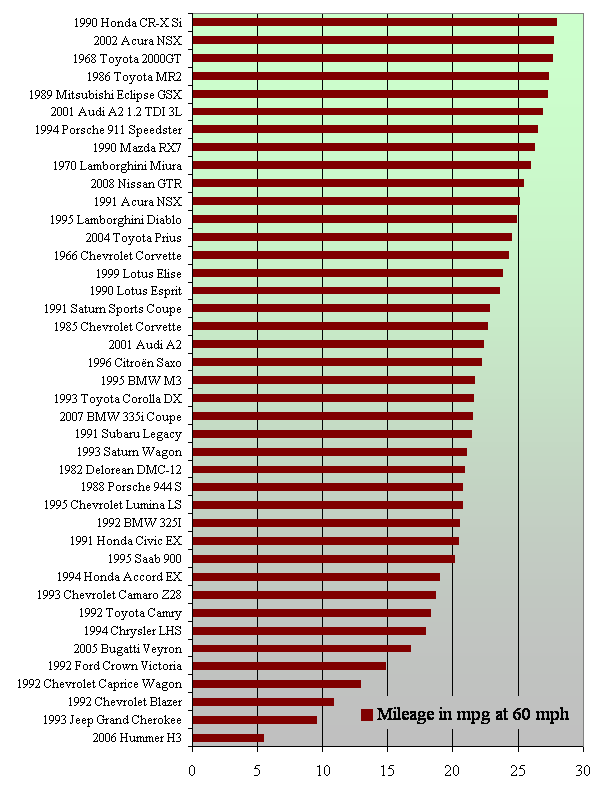|
Word Origin Copyright ©2011 by Paul Niquette. All rights reserved.. |
||
It may astonish some readers to learn that carbon actually accounts for only 27.3% by weight of a carbon footprint (the atomic weights of carbon and oxygen are respectively 12 and 16 which makes 44 the molecular weight of CO2).Apart from metabolism, most of the energy for human activities comes from the combustion of hydrocarbons. For personal transportation in automobiles, the most prominent example, gasoline, is a blend of hydrocarbons derived from petroleum feed stocks, having between 4 and 12 carbon atoms per molecule, with octane (C8H18) being typical. The molecular weight of gasoline will be taken to be 114, so then carbon accounts for 84.2% of the weight of gasoline. Now, a gallon of gasoline weighs about six lbs, so its combustion will put 6 x 84.2 / 27.3 = 18.5 lbs of CO2 into the atmosphere.  ileages in the
diagram below were derived in the solution to the Look-at-Me Car puzzle using
the "60-60 AME" (abbreviation for "60% engine power at
60 mph Aerodynamic Mileage Estimate"). We can see,
for example, that facing aerodynamic drag, the 1994
Honda Accord EX, gets about 18.5 mpg and therefore puts
about one lb of carbon dioxide into the atmosphere for
every mile driven at 60 mph. ileages in the
diagram below were derived in the solution to the Look-at-Me Car puzzle using
the "60-60 AME" (abbreviation for "60% engine power at
60 mph Aerodynamic Mileage Estimate"). We can see,
for example, that facing aerodynamic drag, the 1994
Honda Accord EX, gets about 18.5 mpg and therefore puts
about one lb of carbon dioxide into the atmosphere for
every mile driven at 60 mph.
A car is most fuel efficient at about 23 mph, typically having a carbon footprint at that speed of about 60% of the 60-60 AME. Idling in congested traffic at, say, five mph will increase consumption and emissions up to about the 60-60 AME level.  Consider the electric car. Simply plug it in at night and charge it up. Unplug the thing in the morning and commute at highway speed. As someone wrote in 1985, "Electricity has some handy features." But that same person wrote in 1994, "Apart from lightning, electricity is not a source of energy."Electric power generation throughout the world is dominated by the combustion of fossil fuels. In the U.S. more than two-thirds of electricity (68.3%) comes from burning either coal (44.9%) or natural gas (23.4 %). One-third (31.7%) is produced by non-combustion technologies: hydroelectric, nuclear fission, photovoltaics, solar-thermal, wind-turbines. Accordingly, as a home appliance served by the power grid., the electric car does have a carbon footprint.
 
|
||